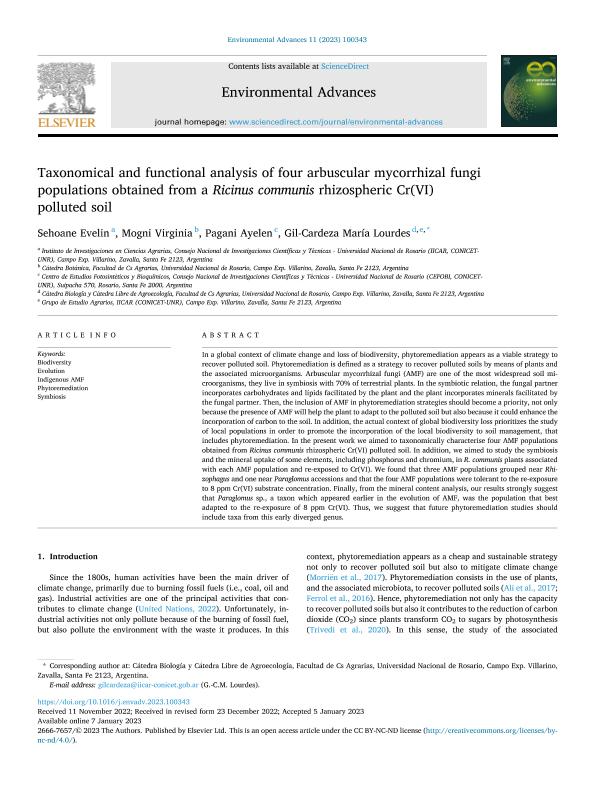Artículo
Taxonomical and functional analysis of four arbuscular mycorrhizal fungi populations obtained from a Ricinus communis rhizospheric Cr(VI) polluted soil
Fecha de publicación:
04/2023
Editorial:
Elsevier
Revista:
Environmental Advances
ISSN:
2666-7657
Idioma:
Inglés
Tipo de recurso:
Artículo publicado
Clasificación temática:
Resumen
In a global context of climate change and loss of biodiversity, phytoremediation appears as a viable strategy to recover polluted soil. Phytoremediation is defined as a strategy to recover polluted soils by means of plants and the associated microorganisms. Arbuscular mycorrhizal fungi (AMF) are one of the most widespread soil microorganisms, they live in symbiosis with 70% of terrestrial plants. In the symbiotic relation, the fungal partner incorporates carbohydrates and lipids facilitated by the plant and the plant incorporates minerals facilitated by the fungal partner. Then, the inclusion of AMF in phytoremediation strategies should become a priority, not only because the presence of AMF will help the plant to adapt to the polluted soil but also because it could enhance the incorporation of carbon to the soil. In addition, the actual context of global biodiversity loss prioritizes the study of local populations in order to promote the incorporation of the local biodiversity to soil management, that includes phytoremediation. In the present work we aimed to taxonomically characterise four AMF populations obtained from Ricinus communis rhizospheric Cr(VI) polluted soil. In addition, we aimed to study the symbiosis and the mineral uptake of some elements, including phosphorus and chromium, in R. communis plants associated with each AMF population and re-exposed to Cr(VI). We found that three AMF populations grouped near Rhizophagus and one near Paraglomus accessions and that the four AMF populations were tolerant to the re-exposure to 8 ppm Cr(VI) substrate concentration. Finally, from the mineral content analysis, our results strongly suggest that Paraglomus sp., a taxon which appeared earlier in the evolution of AMF, was the population that best adapted to the re-exposure of 8 ppm Cr(VI). Thus, we suggest that future phytoremediation studies should include taxa from this early diverged genus.
Palabras clave:
BIODIVERSITY
,
EVOLUTION
,
INDIGENOUS AMF
,
PHYTOREMEDIATION
,
SYMBIOSIS
Archivos asociados
Licencia
Identificadores
Colecciones
Articulos(CCT - ROSARIO)
Articulos de CTRO.CIENTIFICO TECNOL.CONICET - ROSARIO
Articulos de CTRO.CIENTIFICO TECNOL.CONICET - ROSARIO
Articulos(CEFOBI)
Articulos de CENTRO DE EST.FOTOSINTETICOS Y BIOQUIMICOS (I)
Articulos de CENTRO DE EST.FOTOSINTETICOS Y BIOQUIMICOS (I)
Articulos(IICAR)
Articulos de INST. DE INVESTIGACIONES EN CIENCIAS AGRARIAS DE ROSARIO
Articulos de INST. DE INVESTIGACIONES EN CIENCIAS AGRARIAS DE ROSARIO
Citación
Sehoane, Evelin Noelia; Mogni, Virginia Yanina; Pagani, María Ayelén; Gil Cardeza, Maria Lourdes; Taxonomical and functional analysis of four arbuscular mycorrhizal fungi populations obtained from a Ricinus communis rhizospheric Cr(VI) polluted soil; Elsevier; Environmental Advances; 11; 4-2023; 1-11
Compartir
Altmétricas




